

Learnng Styles take your test. Learning-Styles1.jpg (1920x2353 pixels) Social Approaches to Learning. Theory Comparison Chart Nardi (1995) compares and contrasts the various social learning theories, which draws attention to the subtle differences between the theories.

We have prepared a three column chart that organizes these subtle differences. Our hope is that you will find this chart to be a valuable reference tool for future use (i.e. Thought Question #3) or in other courses. (Click on chart for a larger version.) Theories of Learning. Learning styles. Learning style is an individual's natural or habitual pattern of acquiring and processing information in learning situations.

A core concept is that individuals differ in how they learn.[1] The idea of individualized learning styles originated in the 1970s, and has greatly influenced education.[2] Proponents of the use of learning styles in education recommend that teachers assess the learning styles of their students and adapt their classroom methods to best fit each student's learning style. Although there is ample evidence for differences in individual thinking and ways of processing various types of information, few studies have reliably tested the validity of using learning styles in education.[2] Critics say there is no evidence that identifying an individual student's learning style produces better outcomes. David Kolb's model[edit]
A Simple Guide To 4 Complex Learning Theories. Conciselearning. Foundation for Critical Thinking: Books, Conferences and Academic Resources for Educators and Students. Accelerated Lifelong Learning. Concise Learning™ - Learning & Student Success Portal. Multiple Intelligence Institute - MII. Learning Theory v5 - What are the established learning theories?
Learning & Thinking Styles. Learning trough multi knowledge systems. Inspires Learning - Robert O'Toole, University of Warwick. Accelerated Learning. DMLcentral. DML Hub. "Accelerated Learning" Table of Contents. When to Use Social Media for Learning. Workplace learning professionals should focus on how social learning - and its associated tools - can help achieve business goals.
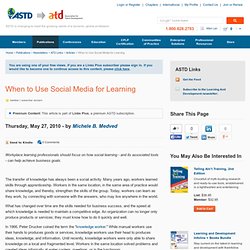
The transfer of knowledge has always been a social activity. Many years ago, workers learned skills through apprenticeship. Workers in the same location, in the same area of practice would share knowledge, and thereby, strengthen the skills of the group. Today, workers can learn as they work, by connecting with someone with the answers, who may live anywhere in the world. What has changed over time are the skills needed for business success, and the speed at which knowledge is needed to maintain a competitive edge.
Waldorf education. Waldorf education, also known as Steiner education, is based on the educational philosophy of Rudolf Steiner, the founder of anthroposophy.

Its pedagogy emphasizes the role of imagination in learning, striving to integrate holistically the intellectual, practical, and artistic development of pupils. The first Waldorf school opened in 1919 in Stuttgart, Germany. At present there are over a thousand independent Waldorf schools,[1] about 2,000 kindergartens[2] and 646 centers for special education,[3] located in 60 countries, constituting one of the largest independent school movements internationally.[4] There are also a number of Waldorf-based public schools,[5] charter schools and academies, and homeschooling[6] environments.
In Continental Europe, Waldorf pedagogy has become a well-recognized theory of education that has influenced public schooling and many European Waldorf schools receive state funding. Montessori education. Children working on the phonogram moveable alphabet[1] Montessori education is an educational approach developed by Italian physician and educator Maria Montessori and characterized by an emphasis on independence, freedom within limits, and respect for a child’s natural psychological, physical, and social development.

Although a range of practices exists under the name "Montessori", the Association Montessori Internationale (AMI) and the American Montessori Society (AMS) cite these elements as essential:[2][3] Addressing diverse learner preferences and intelligences with emerging technologies: Matching models to online opportunities. Ke Zhang Curtis J.
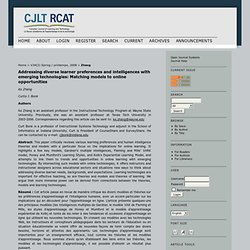
Bonk Authors Ke Zhang is an assistant professor in the Instructional Technology Program at Wayne State University. Previously, she was an assistant professor at Texas Tech University in 2003-2006. Curt Bonk is a professor of Instructional Systems Technology and adjunct in the School of Informatics at Indiana University. Classroom 2.0. Can HighScore House Actually Help Your Kids Do Their Chores? - Lockergnome. Poverty as a Childhood Disease. Photo Poverty is an exam room familiar.
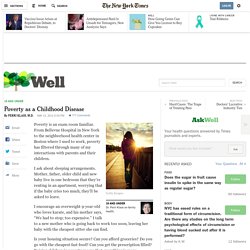
From Bellevue Hospital in New York to the neighborhood health center in Boston where I used to work, poverty has filtered through many of my interactions with parents and their children. Educational Technology and Mobile Learning. Distance Learning Courses and Adult Education - The Open University. Adult+Learning+Theory+Map2.jpg (Image JPEG, 1182x1208 pixels) Sugata Mitra: The child-driven education. Sugata Mitra's 5 favorite education talks. Video channel on TED.com. Open Education. AUTODIDACTIC PRESS - lifelong learning advocate, Charles D. Hayes. Transfert de connaissances. Un article de Wikipédia, l'encyclopédie libre.
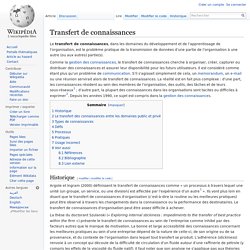
Le transfert de connaissances, dans les domaines du développement et de l’apprentissage de l'organisation, est le problème pratique de la transmission de données d’une partie de l’organisation à une autre (ou aux autres) partie(s). Comme la gestion des connaissances, le transfert de connaissances cherche à organiser, créer, capturer ou distribuer des connaissances et assurer leur disponibilité pour les futurs utilisateurs. Il est considéré comme étant plus qu’un problème de communication. S’il s’agissait simplement de cela, un memorandum, un e-mail ou une réunion servirait alors de transfert de connaissances. La réalité est en fait plus complexe : d’une part, les connaissances résident au sein des membres de l’organisation, des outils, des tâches et de leurs sous-réseaux[1] ; d’autre part, la plupart des connaissances dans les organisations sont tacites ou difficiles à exprimer[2].
Historique[modifier | modifier le code] La connaissance : Cognitive Style as Environmentally Sensitive Individual Differences in Cognition. A Modern Synthesis and Applications in Education, Business, and Management Maria Kozhevnikov, Harvard Medical School, Department of Radiology, Athinoula A.
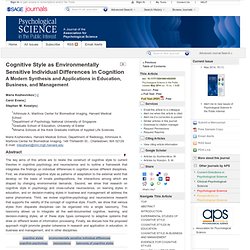
Martinos Center for Biomedical Imaging, 149 Thirteenth St., Charlestown, MA 02129 E-mail: mkozhevn@nmr.mgh.harvard.edu Abstract The key aims of this article are to relate the construct of cognitive style to current theories in cognitive psychology and neuroscience and to outline a framework that integrates the findings on individual differences in cognition across different disciplines. First, we characterize cognitive style as patterns of adaptation to the external world that develop on the basis of innate predispositions, the interactions among which are shaped by changing environmental demands.
Introduction. Scientists propose a new taxonomy to classify cognitive style across disciplines. Educators have tried to boost learning by focusing on differences in learning styles.
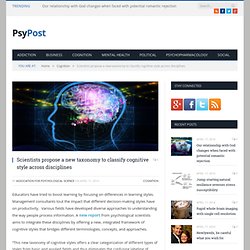
Management consultants tout the impact that different decision-making styles have on productivity. Various fields have developed diverse approaches to understanding the way people process information. A new report from psychological scientists aims to integrate these disciplines by offering a new, integrated framework of cognitive styles that bridges different terminologies, concepts, and approaches.
Ken Robinson says schools kill creativity. Sir Ken Robinson: Bring on the learning revolution! Learning Styles & How To Learn Anything Fast from HowToLearn.com. The Difference Between Instructivism, Constructivism, And Connectivism - The Difference Between Instructivism, Constructivism, And Connectivism by Terry Heick We spend so much time in education trying to make things better.
Better policies. Better technology. Better standards. Better curriculum. Better instruction. Better assessment. Apps for Multiple Intelligences. Periodic Table of Connectivism. What is connectivism? In my last two posts on connectivism (here and here) I've alluded to but not made particularly explicit what I think connectivism actually is, even though I have been critiquing and exploring its boundaries. This post is an attempt to fairly briefly list what I think are among its more compelling shared ideas.
I will draw substantially from George Siemens's most cited seminal article that has acted as a catalyst and gravitational centre for the idea, though I will also be adding odd bits of interpretation and extrapolation here and there that might not have been in the original and to which others have contributed. If connectivism makes any sense at all then knowledge about it is a networked phenomenon, not an individual invention. This is my bit of personal sense-making as I see it on this particular rainy day, not a definitive account to stand for all time, not a scholarly article citing its sources, not a theory, not a refutation of any other model of the idea.
Connectivism_Week1. Don Tapscott: Discovery Learning Is the New Higher Learning. Encyclopedias, record labels and publishers were once in the business of producing unique content that generated big revenues. All are being bludgeoned by the digital age that brought abundance, mass participation, democratized production and the rise of a new delivery channel -- the Internet. A similar fate could soon await Canada's universities. On the surface, they may seem in good health. Distributed Cognition. “The emphasis on finding and describing “knowledge structures” that are somewhere “inside” the individual encourages us to overlook the fact that human cognition is always situated in a complex sociocultural world and cannot be unaffected by it.”
(Hutchins, 1995, p. xiii) Over the 20th century, many have explored the question “how can the cognitive processes we normally associate with an individual mind be implemented in a group of individuals?” All the discussions converged towards the idea that “the cognitive properties of a group can differ from the cognitive properties of the members of the group” (Hutchins, 2000, p. 4). Ed Hutchins has spent his “academic carreer trying to understand human cognition in social, cultural and material context”. He “believe[s] that cultural practices are a key component of human cognition”.